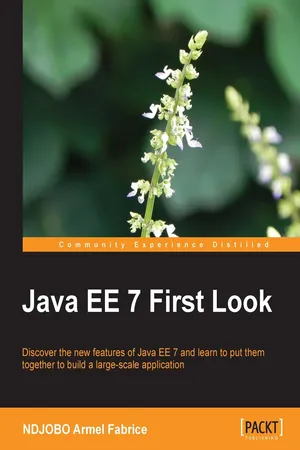![]()
![]()
Table of Contents
Java EE 7 First Look
Credits
About the Author
About the Reviewers
www.PacktPub.com
Support files, eBooks, discount offers and more
Why Subscribe?
Free Access for Packt account holders
Preface
What this book covers
What you need for this book
Who this book is for
Conventions
Reader feedback
Customer support
Downloading the example code
Errata
Piracy
Questions
1. What's New in Java EE 7
A brief history of Java EE
The main goals of Java EE 7
Productivity
HTML5 support
Novelties of Java EE 7
Summary
2. New Specifications
Concurrency Utilities for Java EE 1.0
Why concurrency?
Benefits of concurrency
Risks of concurrency
Concurrency and Java EE
Java EE Concurrency API
Batch Applications for Java Platform 1.0
What is batch processing?
Why a dedicated API for batch processing?
Understanding the Batch API
JobRepository
Job
Step
Chunk
Batchlet
The batch.xml configuration file
JobOperator
Java API for JSON Processing 1.0
What is JSON?
Object
Array
Value
Why JSON?
Java API for JSON processing
The streaming API
The object model API
Java API for WebSocket 1.0
What is WebSocket?
Why WebSocket?
The WebSocket API
Server endpoint
Client endpoint
Summary
3. The Presentation Layer
Servlet 3.1
What is a Servlet?
A login page with a Servlet
Latest improvements of Servlet 3.1 in action
Non blocking I/O API
Protocol upgrade processing
Expression Language 3.0
What is Expression Language?
The latest improvements of EL 3.0 in action
API for standalone environments
Lambda expressions
Collection object support
Collection object construction
Collection operations
String concatenation operator (+=)
Assignment operator (=)
Semi-colon operator (;)
Static fields and methods
JavaServer Faces 2.2
What is JavaServer Faces?
An identification page with JSF
The latest improvements of JSF 2.2 in action
HTML5-friendly markup
Pass-through attributes
Pass-through elements
Resource Library Contracts
Faces Flow
Stateless views
Summary
4. The Java Persistence API
Java Persistence API 2.1
JPA (Java Persistence API)
JPA in action
The latest improvements of JPA 2.1 in action
Persistence context synchronization
Entity
New annotations
Entity graphs
Static or named entity graphs
Dynamic entity graphs
JPQL
Support for stored procedures
New reserved identifiers
Support for creating named queries at runtime
The Criteria API
Support for bulk update/delete
Support for new reserved identifiers
DDL generation
Java Transaction API 1.2
The Java Transaction API
JTA in action
Innovations introduced by JTA 1.2
Summary
5. The Business Layer
Enterprise JavaBeans 3.2
Pruning some features
The latest improvements in EJB 3.2
Session bean enhancement
EJB Lite improvements
Changes made to the TimerService API
Harmonizing with JMS's novelties
Other improvements
Putting it all together
Presenting the project
Use Case Diagram (UCD)
Class diagram
Component diagram
Summary
6. Communicating with External Systems
JavaMail
Sending e-mails in Java
Sending an e-mail via the SMTP protocol
The latest improvements in action
The added annotations
The added methods
The changing of some access modifiers
Java EE Connector Architecture (JCA)
What is JCA?
JCA in action
Latest improvements
Java Message Service (JMS)
When to use JMS
The latest improvements in action
New features
Sending messages asynchronously
Delivery delay
Handling of the JMSXDeliveryCount message property
Simplification of the API
Java API for RESTful Web Services
When to use Web Services
JAX-RS in action
The latest improvements in action
The Client API
Asynchronous processing
Filters and entity interceptors
Filters
Entity interceptors
Summary
7. Annotations and CDI
Common annotations for the Java platform
The goal of this specification
Building your own annotation
Latest improvements in action
The new annotation
Contexts and Dependency Injection
What is CDI ?
Example 1 – instantiation of a POJO
Example 2 – accessing an EJB from a JSF page
Example 3 – setting a bean with a specific scope for simple operations
Example 4 – use of objects usually created by a factory
Latest improvements in action
Avoiding CDI processing on a bean
Accessing the non contexual instance of a bean
Accessing the current CDI container
Destroying CDI bean instances explicitly
Summary
8. Validators and Interceptors
Bean Validation
Validating your data
Building a custom constraint
Creating a constraint annotation
Implementing a validator
Latest improvements in action
Openness
Support for dependency injection and CDI integration
Support for method and constructor validation
Support for group conversion
Support message interpolation using expression language
Interceptors
Intercepting some processes
Defining interceptors in the target class
Defining interceptors in an interceptor class
Latest improvements in action
Intercept constructor invocation
Associating an interceptor with a class using interceptor binding
Creation of interceptor binding types
Declaring interceptor binding
Binding an interceptor by using interceptor binding type
Defining the execution order of interceptors
Summary
9. Security
JASPIC 1.1
Secure access to forms
Implementing an authentication module
Implementing the ServerAuthModule interface
Installing and configuring the authentication module
Binding the authentication module to a web application
Creating a realm
Security configuration
The latest improvements in action
Integrating the authenticate, login, and logout methods called
Standardizing access to the application context identifier
Support for forward and include mechanisms
Summary
Index
![]()
Copyright © 2013 Packt Publishing
All rights reserved. No part of this book may be reproduced, stored in a retrieval system, or transmitted in any form or by any means, without the prior written permission of the publisher, except in the case of brief quotations embedded in critical articles or reviews.
Every effort has been made in the preparation of this book to ensure the accuracy of the information presented. However, the information contained in this book is sold without warranty, either express or implied. Neither the author, nor Packt Publishing, and its dealers and distributors will be held liable for any ...
